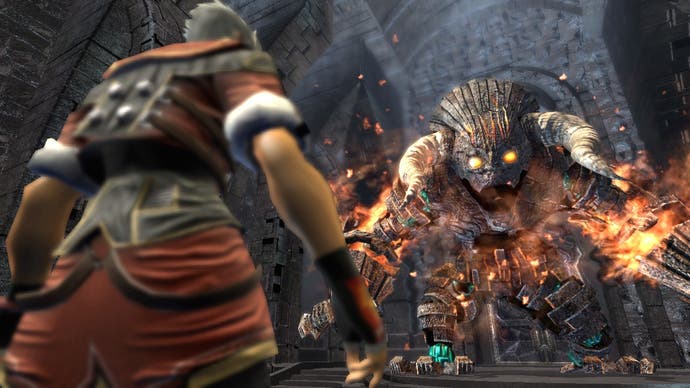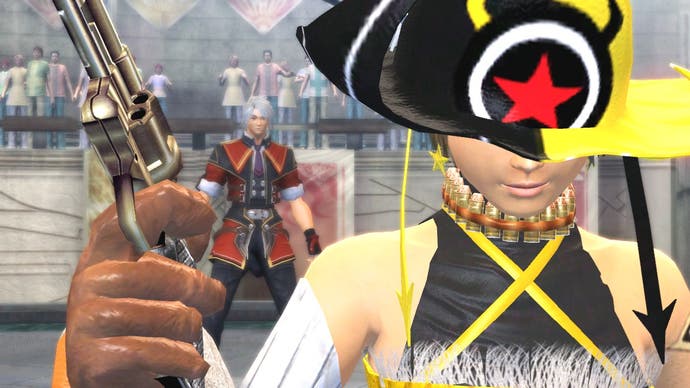Enchanted Arms
Grabs you.
Yes, they literally mean he's got an enchanted arm.
The titles of Japanese games are meant to be entertainingly mental, possibly carrying a certain broken-English charm. They're not meant to be literal - that's cheating. Just as Final Fantasy and Shadow Hearts featured remarkably little in the way of terminal wet dreams or occluded cardiac organs, and Elemental Gearbolt wasn't, er, whatever the hell that even means, so Enchanted Arms was originally assumed to be simply another collection of nice English words that some well-meaning Japanese chap had liked the sound of and stuck together for no apparent reason.
The last thing I expected, then, was that Enchanted Arms would turn out to be the Snakes On A Plane of the Japanese RPG world. It states its case up front, with no bones being made about its content - aside, possibly, from a humerus, a radius and an ulna. It's about a bloke with an arm which is enchanted. An enchanted arm. Do you see?
Actually, that's not the very last thing I expected. To be entirely accurate, the very last thing I expected was that Enchanted Arms would be any good. A Japanese role-playing game developed by a company better known for headache-inducingly hardcore stompy mech games, released early in a console's lifespan - and most of all, released on the Xbox 360, a platform which currently sells about as well in Japan as souvenir mugs with Pope Benedict's face on them do in Islamabad? A game destined to be still-born, surely? Perhaps not.
Two Short Planks

As previously and somewhat incredulously mentioned, Enchanted Arms follows the adventures of a young man with an enchanted arm, which actually isn't remotely as much fun for him as you'd imagine. You see, his arm actually has the mysterious power to remove enchantments from anything it touches - which, given that he attends a school for enchanters and lives in a city filled with machinery which works on the basis of enchantment, makes him somewhat unpopular. What also makes our hero Atsuma unpopular is the fact that he's absolutely, unremittingly stupid - with even his closest friends acknowledging that while he's quite handy on the practical side of things, he apparently doesn't have two brain cells to rub together.
Alarm bells should go off at this point. Are we really about to spend tens of hours following around some lunk with a brain cavity filled entirely with houmous and cream cheese as he bumbles from one situation to the next, ignoring the obvious and driving the player to towering heights of frustration with his inability to find solutions which are staring him in the face? Um... Sort of, yes. However, to Atsuma's credit, he's a likeable lummox, lacking the emo angst of many RPG protagonists - a lot of whom would seem more at home on LiveJournal than on the deck of an airship heading out to save the world. To the credit of the game script writers, meanwhile, Atsuma is largely bolstered by a supporting cast of intelligent characters who point out those obvious solutions quickly enough to alleviate much frustration, and whose eye-rolling at Atsuma's stupidity helps the player to identify more readily with the cast. There's even a running joke early in the game where the rest of your team gives you detailed instructions on how to use items such as chests, ladders and buttons (all of which just involve pressing A), while Atsuma enthusiastically celebrates learning these tricky new skills.
Central character aside, the storyline is fairly standard Japanese RPG fare; it's set in a post-apocalyptic world where, thousands of years after the destruction of a magical war in which autonomous ultimate weapons called Devil Golems were unleashed, civilisation is recovering under the protection of a number of great cities built using the power of enchanting. This, of course, is boring, so it's important that a Great Threat (the resurrection of the Devil Golems) should pop up for the Unlikely, Reluctant Hero (that would be Atsuma) to fight against, but only after coming to terms with his own Dark, Hidden Secret (his enchanted arm and the mysterious powers it unleashes). It's all quite nicely written, and features a number of sub-plots involving various characters you'll run into (all of whom have Dark Secrets of their own, although obviously not as exciting as Atsuma's enchanted arm) - all of which plays out in an astonishingly linear fashion, with sub-plots being dumped into the game such that you'll actually need to complete them before the main plot continues, rather than being in any way optional.
By The Nose

Whether this prospect sounds interesting or downright awful to you is really what separates fans of Japanese RPGs from the rest of the world, since those in the former camp accept that to a greater or lesser degree, the vast majority of the JRPG pantheon is really more interactive visual novel than role-playing game. Enchanted Arms is an extreme example of this, with the most involved side-quest you'll have the option of doing being to take a deliberate wrong turning, finding an optional golem boss (more on those in a moment) or chest full of items at the end of your short detour. Then it's back to the main path, and off again down the clearly signposted street.
Thankfully, though, it's a very nice street. Graphically, From Software has pulled out all the stops and created one of the best-looking early Xbox 360 titles, with truly stunning world environments, creative, interesting looking characters and creatures, and superb special effects in battles (all of which can be fast-forwarded if you're getting sick of watching the animations, which is a nice addition that makes the game much more pleasant to play). The world environments in particular are worthy of note, because this is one of the first Xbox 360 games where there were regular moments of standing around gawping at the world - especially in the opening segment of the game, which is set around an academy not dissimilar to Balamb Garden in Final Fantasy VIII. The comparison is useful, because Enchanted Arms, running in real-time, looks better than the computer-generated backgrounds and pre-rendered videos used in that game - and From Software hasn't been afraid to throw showy special effects into its environments either, such as fountains and waterfalls which refract and distort the scene behind them realistically.
The game also largely eschews rendered scenes, and manages some truly stunning cut-scenes in the game engine - which really adds to the drama of the scenes in an unexpected way, since there is no longer a clear line between watching a movie scene and viewing an in-game scene. It's only with the removal of this division that you realise just how jarring that transition has been for the last two generations of Japanese RPGs, because we have become so accustomed to rendered scenes indicating really dramatic story moments that we've come to treat them differently to the rest of the game. With this distinction removed, the whole game feels more coherent and the experience as a whole is improved - a significant plus point for Enchanted Arms, and something we hope to see become the norm in next-gen RPGs.
However, not all is well on the graphical front - and the fact that Enchanted Arms was a relatively early title on the Xbox 360 shines through as you get to later stages of the game, where environments become more drab and less populated with interesting architecture and characters. There's a strong feeling that much of the development effort went into the early stages of the game, and while the storyline continues to belt forward at a fast enough pace to be satisfying as the end nears, the environments are definitely disappointing, with a somewhat unfinished feel.








